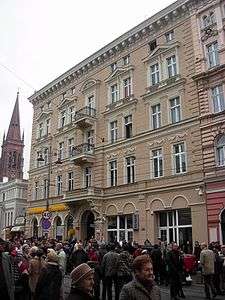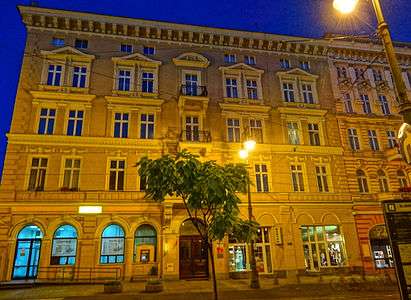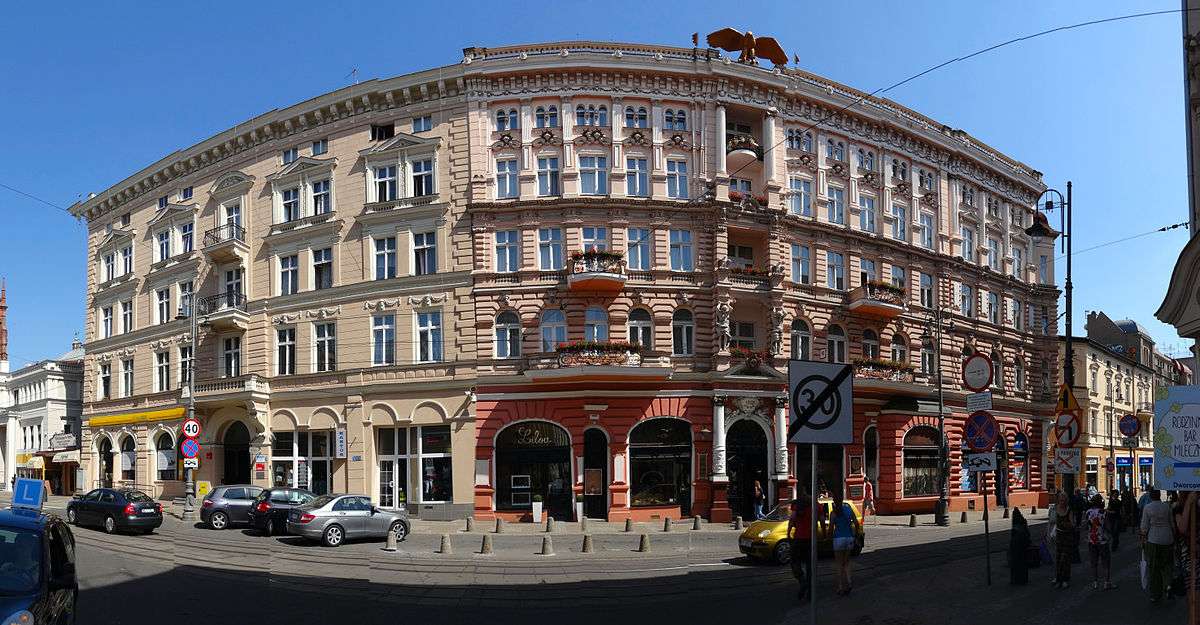Emil Bernhardt tenement in Bydgoszcz
| Emil Bernhardt tenement | |
|---|---|
| Polish: Kamienica Emila Bernhardta w Bydgoszczy | |
|
Emil Bernhardt tenement in Bydgoszcz, view from Gdanska street | |
 Location within Poland | |
| General information | |
| Type | Tenement house |
| Architectural style | Eclecticism |
| Classification | N°735497-reg.A/1558, 30th April 2010[1] |
| Location | Bydgoszcz, Poland |
| Country | Poland |
| Coordinates | 53°7′33″N 18°0′12″E / 53.12583°N 18.00333°E |
| Construction started | 1882 |
| Inaugurated | 1884 |
| Design and construction | |
| Architect | Carl Stampehl |
| Wikimedia Commons has media related to Emil Bernhardt House. |
Emil Bernhardt House is a tenement located at Gdańska Street N°16, in Bydgoszcz, Poland.
Location
The building stands on the eastern side of Gdańska Street, at the intersection with Dworcowa street. It is adjacent to Hotel "Pod Orlem" and is similar in terms of style and dimensions. It is close on the other side to the Pomeranian Arts House, a concert hall, and on the east, the building is bordered by the Park Casimir the Great.
History
The land on which the building stands bought around 1850 by a baker,[2] August Friedrich Bernhardt.[3] Between 1875 and 1879, the newly created company was taken over by his son Emil Bernhardt, coming from Switzerland where he attended hotel and catering professional courses.[3] In 1880 Emil Bernhardt married Louise Müller, daughter of a landlord from the vicinity of Schneidemühl, who made a very substantial dowry. A part of this dowry has been probably invested in the construction of Emil Bernhardt's house[3] adjacent to the plot where stands Hotel "Pod Orlem".[3]
The design of the edifice, realized by master mason Carl Stampehl, was approved on February 13, 1882. The three-storey building displays a facade with Eclecticism style, reminiscent of the Italian Renaissance palaces. It was a construction in the type of German "Geschäftshaus" (house and commercial building), with lodgings upstairs and cafés on the basement.[3]
In 1918, a remodeling of the premises on the ground floor was carried out by architect Gustav Bruschat to house a branch of the Deutsche Bank. In 1920, another reconstruction was performed by architect Rudolf Kern.[4]
From 1920, the building housed one of the finest Bydgoszcz café, the "Wiener Café" .[4]
During interwar period, the Agrarian Bank (Polish: Bank Agrarny) and Poznan BGK (Polish: Bank Gospodarstwa Krajowego) had their headquarters there, along with the German Society for Science and Arts.[5]
Architecture
The building has got a horseshoe shape, following Eclecticism style with classicist forms.[4] The edifice not only provides a balanced facade, but also displays remains of a unique originally polychrome covering all walls of the hallway crossing.
In the courtyard, at the back of the lot is located a residential building with an iron porch and a decorative openwork peak, built in 1882 and designed by master mason Carl Rose.[4]
The building has been put on the Pomeranian heritage list (N°735497-reg.A/1558), on 30 April 2010[1]
Gallery
 Main facade with St Peter's and St Paul's Church in Bydgoszcz in background
Main facade with St Peter's and St Paul's Church in Bydgoszcz in background- Hallway crossing with frescoes on walls
- Antique style frescoes (detail)
 The Wiener cafe in the tenement
The Wiener cafe in the tenement Emil Bernhardt house by night
Emil Bernhardt house by night
See also
Bibliography
- (Polish) Bręczewska-Kulesza Daria, Derkowska-Kostkowska Bogna, Wysocka A., [i inni]: Ulica Gdańska. Przewodnik historyczny, Bydgoszcz 2003
- (Polish) Jastrzebska-Puzowska Iwona: Hotel „Pod Orłem". [w.] Kronika Bydgoska XIV 1992. Bydgoszcz 1993.
References
- 1 2 Rejestr zabytków nieruchomych – województwo kujawsko-pomorskie (pol.).31 grudnia 2014 [issued 1.03.2014]
- ↑ Adress und Telefonbücher von Bromberg-1855-p.8
- 1 2 3 4 5 Jastrzebska-Puzowska Iwona: Hotel "Pod Orłem". [w.] Kronika Bydgoska XIV 1992. Bydgoszcz 1993
- 1 2 3 4 Bręczewska-Kulesza Daria, Derkowska-Kostkowska Bogna, Wysocka A., [i inni]: Ulica Gdańska. Przewodnik historyczny, Bydgoszcz 2003
- ↑ Deutsche Wissenschaftliche Zeitschrift für Polen: Neue Folge der Zeitschriften der Historischen Gesellschaft für Posen und des Deutschen Naturwissenschaftlichen Vereins für Großpolen, zugleich Veröffentlichung der Deutschen Gesellschaft für Kunst und Wissenschaft in Bromberg und des Coppernicus-Vereins für Wissenschaft und Kunst in Thorn, by Lattermann, Alfred - 1938
